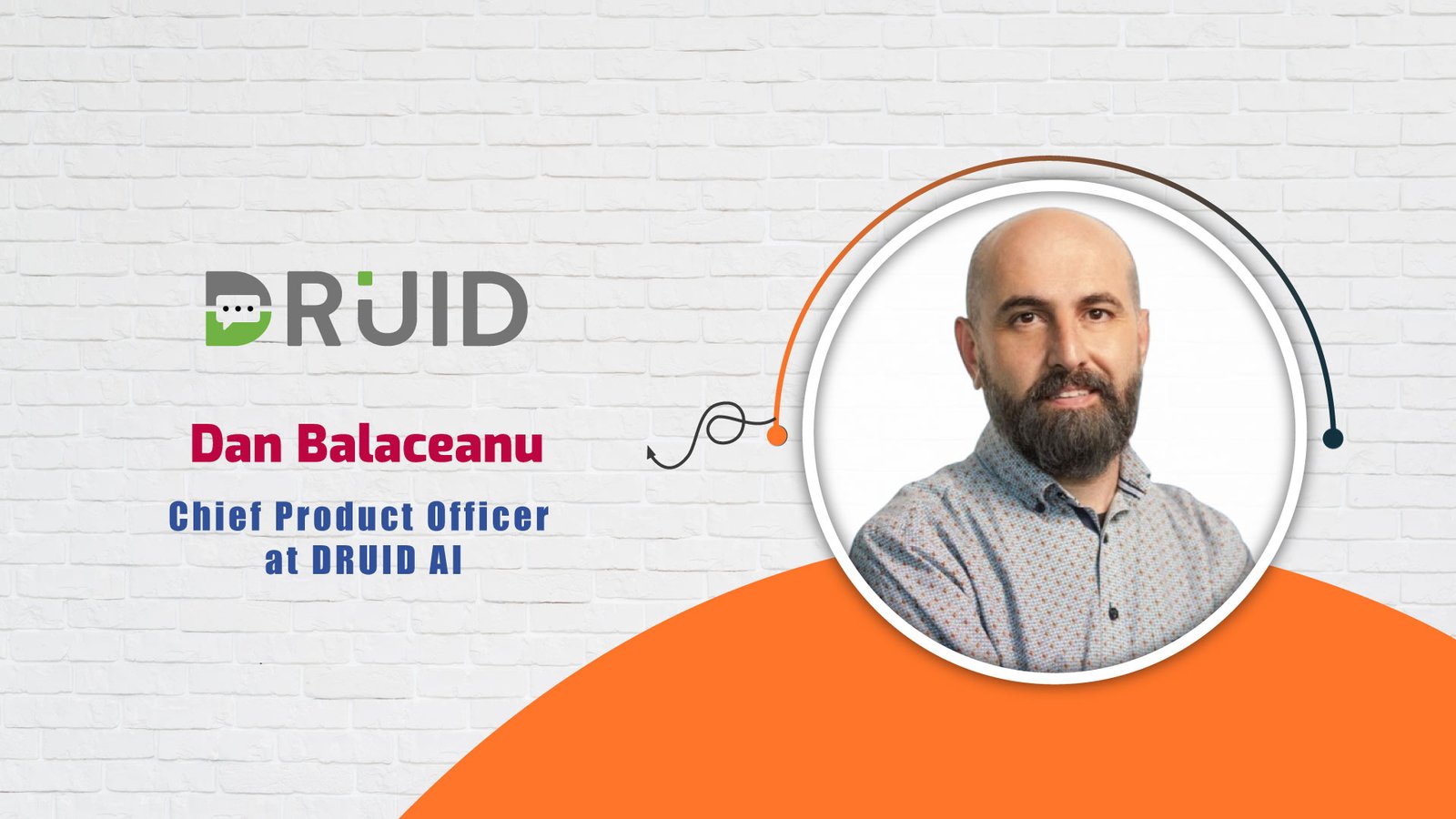AITech Interview with Dan Balaceanu, Chief Product Officer at DRUID AI
Witness the way conversational AI is reshaping industries, overcoming challenges, and driving efficiency across businesses. Hi Dan, please share a bit about yourself and your professional background. Also, tell our readers what led you to your current role at DRUID AI.Hi, I’m Dan Balaceanu. I’m the Chief Product Officer and... The post AITech Interview with Dan Balaceanu, Chief Product Officer at DRUID AI first appeared on AI-Tech Park.

Witness the way conversational AI is reshaping industries, overcoming challenges, and driving efficiency across businesses.
Hi Dan, please share a bit about yourself and your professional background. Also, tell our readers what led you to your current role at DRUID AI.
Hi, I’m Dan Balaceanu. I’m the Chief Product Officer and co-founder of DRUID AI. I’ve spent over 20 years building enterprise-level business applications – which provided me with learnings that have been hugely impactful in my role today. Because I spent the bulk of my time in previous roles building complex ERP systems in highly regulated industries, such as accounting, financial services, and healthcare, I knew the business requirements and complexities of building in a traditional way.
My journey into AI began when I recognized its potential to simplify the way my teams and I worked, especially when building solutions for highly regulated environments. This inspired me to co-create DRUID AI in 2018, where we’ve integrated AI, machine learning, and natural language understanding to help businesses improve the overall user experience. It’s been exciting to see how business needs that have existed for decades can now be solved in a different and better way with AI technology. Because of this, I now look at almost any problem I’m presented with from the perspective of how AI can improve or solve that particular need.
Can you describe your understanding of how conversational AI transforms business operations?
The speed at which conversational AI is growing and evolving creates such value. It’s the source of energy that’s fueling our work at DRUID AI and others in building applications and end-to-end solutions. When businesses implement this technology, the speed at which they can respond to their customers and employees is unmatched.
For example, in an HR setting, DRUID’s conversational AI platform helps to simplify the entire HR process through the automation of day-to-day activity. It optimizes common tasks such as onboarding, recruitment, and retainment with ease by lifting the burden on employees in building out their teams. This technology can help HR leaders narrow down the candidate pool by identifying the right candidates to move forward, making the process less time consuming on both sides.
Another example is the work we’re doing in the higher education space with Georgia Southern University. The introduction of Gus completely transformed student interactions by providing 24/7 access to personalized information and services. The 26,000+ students at Georgia Southern now all benefit from continuous support, and with over 300,000 messages sent so far with a less than 1% opt-out rate, we saw widespread acceptance and positive impact of the program. Not to mention, the school also saw over $2.4 million in additional revenue from bringing on Gus.
What kind of challenges do you see businesses face when implementing AI solutions?
I often see the misalignment between expectations and reality when companies don’t connect AI to their overall business goals. Users tend to forget that AI is not a one-size-fits-all solution – the way a Chief Financial Officer would use AI in their role is vastly different from how a college admissions officer would use it.
To mitigate this challenge, businesses need to drill down on why they want to use AI. Do they need to answer customer calls quicker? Do they need to speed up the way they package orders? Do they need to provide their teams with always-available resources easily? By figuring out where AI is needed most and why, businesses can identify and implement the right solution to meet their needs.
Another challenge for organizations is how to approach testing. Stringent testing of AI solutions before they are consumer-facing is another one of the most important steps businesses can take to safeguard the experience and mitigate risk. By having a testing tool where the entire flow is tested using turn-based conversations with an LLM playing the role of a persona, businesses can more accurately assume the general success of the conversation. In addition, it’s important that businesses combine AI-generated scenarios in tandem with imported real-world cases in these testing scenarios to ensure that AI solutions are trained to handle an array of conversations.
What role does conversational AI play in minimizing the gap between different applications used within any organization?
Businesses are under mounting pressure to drive revenue, increase employee retention and produce better customer outcomes. AI is the answer to these problems, and the way forward. The opportunity that AI affords global markets is huge: Some estimates suggest that AI technology could generate $15.7 trillion in revenue by 2030, boosting the GDP of local economies by an additional 26%.
While businesses are all keen to jump to this fully realized and successful future, the reality is that there are countless AI tools and services claiming to solve the challenges modern businesses face today, with few solutions actually able to connect all of the dots.
The real power of AI, for organizations of all sizes and maturities, lies in the ability to simplify and connect, enabling better adoption, more automation, and deeper intelligence. Conversational AI should seamlessly integrate with a variety of systems and data sources within an organization. That way, companies can leverage the full potential of their in-house data. It’s an exceptional tool for enabling employees to access and use relevant data without having to toggle multiple applications, by connecting platforms into a single conversational interface. This integration reduces the time spent on manual tasks and also pushes forward more data-driven conversations (that are highly accurate and personalized).
As we know, lack of integration can hinder efficiency in businesses. What strategies would you recommend for a company to streamline its AI tools and applications?
My first recommendation is not to start from scratch—assess your current technologies to identify gaps and areas where AI can add value. Choose solutions that integrate seamlessly with your existing systems to ensure a smooth flow of information across applications and platforms. A well-integrated AI system will enhance collaboration between different tools and work to lessen any disruptions that could occur from multiple tech stacks.
When you are looking to implement new AI tools and applications, in order to improve overall outcomes, it should be a top priority to conduct thorough testing. Response accuracy, customizability, and privacy are priorities, and testing them allows you to gauge how well the AI will enhance your workflows. It can also reveal any potential areas for fine-tuning, such as improved response times or better privacy practices. Due diligence in testing will result in the AI functioning as expected and promote healthy performance outcomes.
It’s also important to prioritize flexibility by selecting AI tools that are scalable and adaptable to future business needs, whatever they may be. This way, you can be confident that your AI systems will support your business as it grows or shifts focus, keeping you competitive and helping your technology evolve with these changes.
What are the ways in which businesses ensure that their AI solutions are user-friendly and meet customer needs?
To make sure AI is creating positive experiences for customers, businesses can take the steps to create personalized interactions by leveraging their analytics – including customer behavior, preferences and feedback. Companies can use these insights to tailor their AI responses and recommendations to be certain that the outputs will address the unique, relevant needs of every customer for improved interactions.
Conversational AI in particular allows for real-time support where users can ask anything and receive round-the-clock assistance. Customers appreciate this level of responsiveness – it helps them recognize that their needs are important to us. With advancements in technology resulting in customers expecting immediate assistance, companies that provide this are more likely to keep them satisfied.
Clear and concise communication is also key here, because with so much information being thrown at them, customers need clear explanations into processes and offerings to avoid them getting overwhelmed. AI solutions are especially user friendly because they can offer tutorials or step-by-step guides within the click of a button. The one thing to keep in mind is that you need to stay in contact with your customers to make sure they feel valued and supported throughout the process. Regular check-ins, requests for feedback, and updates on tweaks and improvements will show commitment to evolving AI offerings based on customer needs.
Can you mention some pain points employees face when using multiple applications and how AI can play a role in addressing these issues?
Using multiple applications takes employees out of their flow state, as they waste valuable time having to toggle between them and can also be unsure of which ones are actually helpful to them. This frustration with using multiple applications can result in employees not being as productive or having a lack of clarity about how to use these tools to their advantage.
Conversational AI allows employees to access all the information they need in one place. Integrating bots into existing systems can benefit employees as they can receive instant responses to their questions and no longer have to spend time navigating multiple platforms. Think of this technology as providing every employee their own AI agent to assist their daily work needs.
It acts as a personal assistant that helps teams use their tools and time more effectively – which is a great morale booster.
How do you think upskilling employees in both technical and manual skills will create an impact on the adoption of AI in the workplace?
Upskilling is incredibly important here. As professionals are expected to become more proficient with AI tools, they need the proper insights on how to leverage these solutions. If done right, they can use them to completely transform their workflows. It can automate repetitive tasks, allowing employees to focus on creative and strategic tasks like decision-making and problem-solving. And by being able to provide data-heavy insights, it also enables them to make informed decisions faster.
For example, in the healthcare setting, conversational AI chatbots can support providers by quickly triaging symptoms and managing appointment schedules, allowing them to dedicate more time to patient care instead of administrative tasks. And in HR, chatbots can streamline the onboarding process by automating document collection and answering common questions – which not only accelerates onboarding timelines but also ensures new hires feel supported and informed from the get-go.
When employees are empowered with the skills to make the most out of AI, that’s where they see the most impact. It goes to show how speed, efficiency, and personalization can all be amplified when AI is integrated – and people are taught how best to leverage it – into business solutions.
In what ways do you think AI will change the landscape of competitive advantage in organizations?
The real power of AI, for organizations of all sizes and maturities, lies in its ability to simplify and connect – enabling better adoption, increased automation, and deeper intelligence that keeps businesses competitive. No AI technology exemplifies this better than conversational AI. DRUID’s own Conversational Business Applications (CBA) provide a blueprint for businesses to map their current needs toward a future of unlimited potential.
CBAs allow organizations to see the bigger picture within the context of their business, helping them focus on the entire customer journey. This broader perspective triggers intelligent actions, such as personalized recommendations and proactive support, delivering real value for businesses, employees, and customers. Additionally, the data generated from these interactions offers insights into consumer behavior and market trends, which can inform strategic decisions.
Can you give some advice to our readers on how to measure the success of conversational AI and its initiatives?
To measure the ROI of conversational AI, look beyond basic performance metrics. Traditional metrics like accuracy, response time, and task completion rates are important – but they don’t tell the whole story. Users need to comprehensively track various metrics to assess how well the AI aligns with their organizational goals, and the use cases they set out to solve.
It’s key to also focus on the quality of interactions, aiming for engaging and empathetic responses that keep customers and users happy. A successful conversational AI platform will demonstrate adaptability, a thorough understanding of user inputs, and maintain coherent responses. Additionally, regular analysis of user feedback will give you insights into how the AI is performing and highlight areas for improvement, so companies can learn from their initiatives and extend those benefits into other areas.
Lastly, you should always track back to your original KPIs, and ensure you have accurate analytics at all times. That way, you can align with the big picture business goals. How did the solution translate to cost savings across the organization? Revenue? This will inform the total ROI for your business.

Dan Balaceanu
Chief Product Officer at DRUID AI
Dan Balaceanu, co-founder and Chief Product Officer at DRUID AI, is a highly proficient Solutions Architect and Technical Project Manager with more than 15 years in leading mid-size development and implementation projects, with systems analysis, application development and testing for customer-focused teams.
The post AITech Interview with Dan Balaceanu, Chief Product Officer at DRUID AI first appeared on AI-Tech Park.


 Editor-Admin
Editor-Admin 





